|
|
|
Sort Order |
|
|
|
Items / Page
|
|
|
|
|
|
|
| Srl | Item |
| 1 |
ID:
179336
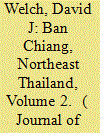

|
|
|
|
|
| Summary/Abstract |
These three volumes, along with the forthcoming Volume 2D, the catalogue of metal and metal-related finds, present the results of a thorough, detailed study of the metals recovered during archaeological investigations in 1974 and 1975 at the village of Ban Chiang and three smaller sites in the northern part of northeast Thailand. At a time when little was known of Southeast Asian prehistory, the finding of very elaborately painted earthenware pottery vessels, probably prehistoric, at Ban Chiang stirred the interest not only of archaeologists, but also, unfortunately, from the standpoint of scientific investigation of the past, that of looters, dealers, and collectors of antiquarian art. In order to recover a sample of these vessels in their original depositional context, the Thailand Fine Arts Department and the University of Pennsylvania undertook one of the largest excavations of a prehistoric site carried out in Southeast Asia at the time. What subsequently caused added excitement in the media and the scientific community was the recovery of artefacts of iron that appeared to date to the second millennium BCE and of copper or bronze associated with dates in the fourth millennium BCE, perhaps as early as 3600 BCE, seeming to confirm similar early dates for bronze working from the nearby site of Non Nok Tha. Such early dates suggested the possibility of an independent development of metallurgy in Southeast Asia. Because of the importance of the excavation at Ban Chiang as a milestone in Thai and Southeast Asian archaeology, the site was later placed on the UNESCO World Heritage List.
|
|
|
|
|
|
|
|
|
|
|
|
|
|
|
|
| 2 |
ID:
108325
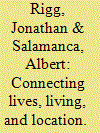

|
|
|
|
|
| Publication |
2011.
|
| Summary/Abstract |
This article explores mobility transitions in Thailand through the particular experience of two villages in Northeast Thailand over the period from the early 1980s through to 2009. The authors show through the mobility histories of Ban Non Tae and Ban Tha Song Korn that, while rural settlements may have always had a greater degree of mobility than the sedentary peasant paradigm suggests, important changes have taken place over the last quarter of a century in how that mobility is manifested. Personal mobility has increased; the migration of women has become as prevalent as that of men; and a mixture of daily commuting and more permanent moves have replaced seasonal circulation. In the process, mobility has created complex, multi-sited households; has led to a growing geriatrification of farming; and has altered the basis for livelihood sustainability and village resilience. Case studies of two individuals highlight these dynamics and add color to the themes the authors present. In making clear households' changing spatial signatures, the authors also seek to show how national and international development processes are imprinted in village and household histories.
|
|
|
|
|
|
|
|
|
|
|
|
|
|
|
|
| 3 |
ID:
137224
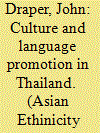

|
|
|
|
|
| Summary/Abstract |
This article examines the introduction of multilingual Thai/Thai Lao/English signage in commercial areas of the Faculty of Humanities and Social Sciences at Khon Kaen University, the principal tertiary university for the 19 million citizens of Northeast Thailand, the majority of whom are of the minority ‘Thai Lao’ ethnicity, an ideological construction that is presented in some detail. This introduction of signage followed a previous study to introduce officially sanctioned multilingual direction-giving signage, including the main faculty sign, in three prominent areas of the Faculty. The survey employed a complex methodology to survey the opinions of 300 students together with observation of students and interviews with members of the faculty. The research type is therefore a mixed-methodology investigation of identity and language policy planning, cultural promotion, glocalization, Gal and Irvine’s semiotic ideology structuration process, the (urban) linguistic landscape and Bourdieu’s theories of social reality. The study found high levels of support for the signage from the student body, members of the faculty and the stallholders themselves.
|
|
|
|
|
|
|
|
|
|
|
|
|
|
|
|
| 4 |
ID:
144846
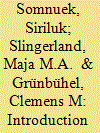

|
|
|
|
|
| Summary/Abstract |
As part of the Thai Government's objective to increase energy security through biodiesel, oil palm was introduced to Northeast Thailand in 2005. Nong Khai Province was selected as a pilot project because of its suitable environmental conditions. This study assesses the acceptance of policy interventions and socio-economic conditions by adopters and non-adopters. We found that total farmland size was significantly higher among oil palm producers than among non-producers. Nevertheless, the area under oil palm cultivation did not increase in accordance with land size in the way rubber did. Oil palm and non-oil palm farmers had almost equal amounts of rice area thereby providing household food security. Oil palm did not replace food crops. Farmers investing in oil palm tend to base their livelihood around on-farm production, whereas non-adopters tend to diversify with off-farm income sources. Oil palm was found to be one component of a diversified farming system and an additional income source, albeit not the primary one. In conclusion, oil palm was a crop that had been tried by (wealthier) farmers with sufficient capital, and an aim to further diversify on-farm household income. Oil palm is certainly not (yet) contributing substantially to household income in Thailand's Northeast.
|
|
|
|
|
|
|
|
|
|
|
|
|
|
|
|
| 5 |
ID:
107194


|
|
|
|
|
| Publication |
2011.
|
| Summary/Abstract |
The experience of disability in the global South remains relatively underreported in spite of the greater focus on disability as both an impediment to development and frequently as a result of development. This article reports a qualitative study using ethnographic techniques undertaken in the province of Khon Kaen in Northeast Thailand. The primary participants were men who had experienced a severe spinal cord injury at a time when they were breadwinners, a role which is significant in the context of a modernising state that is an active participant in a global economy. The experiences, constructions and beliefs of these men, their family carers, and other informants illustrate the complex ways in which social and cultural factors interact with the opportunities, challenges and constraints of the transition modernity. The findings, interpreted according to the 'three bodies' approach, illustrate the intersection of colonising effects, governmentality and resistance, and embodied experience in a cultural context.
|
|
|
|
|
|
|
|
|
|
|
|
|
|
|
|
| 6 |
ID:
157735
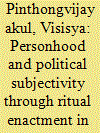

|
|
|
|
|
| Summary/Abstract |
This article examines the relationship between an important local spirit cult and the construction of Isan political identity in Chaiyaphum province, northeast Thailand. Isan subjectivity has largely been studied through social or political-economic lenses. This study looks, however, at the spiritual experiences and ritual performances that crucially manufacture a local version of personhood. The spectacular annual performance of social memory and historical commemoration of Phaya Lae is constitutive of political identity for the people of Chaiyaphum province. I argue that the rituals surrounding the Phaya Lae cult enable the people of Chaiyaphum to perceive their subjectivity as Thais via the integration of the deity into the historical imagination of the state. I argue further that such local performances of spirit cults sustain Thailand as a ‘ritual state’ in which power and prestige are maintained by ritual enactments both in everyday life and ceremonial events. Through mediumship, the periphery draws charisma from the central Thai state and in turn ritually sustains the potency of the centre.
|
|
|
|
|
|
|
|
|
|
|
|
|
|
|
|
| 7 |
ID:
147669
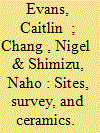

|
|
|
|
|
| Summary/Abstract |
Our understanding of the transition from the last centuries of prehistory to the Pre-Angkorian period in northeast Thailand has been limited by a lack of projects bridging both periods. This article examines settlement patterns of the first to the ninth centuries CE in the Upper Mun River Valley based on recent (2012–14) surveys. The findings highlight the gradual settlement trends in the region, with a focus on local modification rather than the sudden adoption of external ideas. Results reinforce the fourth to sixth centuries CE as a pivotal period, when large centres consolidated and cautiously expanded upriver, into previously uninhabited regions. A relatively modest, flexible, and resilient settlement strategy developed, attuned to wider supra-regional trends, but allowing for the demands of the local cultural and physical landscape.
|
|
|
|
|
|
|
|
|
|
|
|
|
|
|
|
| 8 |
ID:
157951
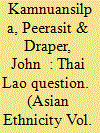

|
|
|
|
|
| Summary/Abstract |
This article presents an anatomy of the 2011 Thailand Country Report to the Committee responsible for the UN Convention for the Elimination of All Forms of Racial Discrimination, in which Thailand recognized its largest ethnic minority community, the Thai Lao, to the international community. The article analyses the Country Report as well as the deliberations of the Committee in dialogue with the Thailand Country Delegation. It provides a policy context for the Country Report, including Thailand’s classification of ethnic communities. The article argues the need to minimize racialized discrimination as regards the Thai Lao. Five policy issues, framed in the context of inclusion and which arise from the recognition of the Thai Lao by the Country Report, are considered. The article concludes by discussing how the Thai Lao may be better included in Thailand via political developments towards a social democracy in Thailand, for social democracy can recognize sociocultural rights.
|
|
|
|
|
|
|
|
|
|
|
|
|
|
|
|
|
|
|
|
|